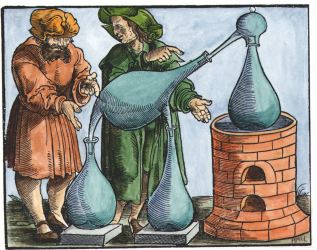| Author | Post |
|---|
Paul Ferguson
Member

| Joined: | Fri Feb 15th, 2008 |
| Location: | |
| Posts: | 1538 |
| Status: |
Offline
|
|
Posted: Mon Jan 19th, 2009 05:16 pm |
|
I have finished translating the Bonacina and am just clearing up a few outstanding queries.
I cannot make sense of the letter H.(?) in the passage below, which is from the chapter on the time the Alchemical Work requires, and which seems to read:
'Item Raimundus Lullius in libro de Quinta Essentia distinctione tertia ait: Sciat Artista in nullo opere Alchymico tempus omnino certum fuisse, quia noster Infans aliquando citius, aliquando tardius, ut patet in foetu, quoniam aliquando oritur ad Menses septem, aliquando ad Novem: sed Artistae signum erit, quando H.(?) rubrum apparuerit'.
'And likewise Ramon Llull, in part three of his Book 'De Quinta Essentia', remarks: 'The Artist knows that in no alchemical operation has the timing ever been completely certain, because our Infant arrives sometimes earlier, sometimes later, as is apparent in the foetus, seeing that it sometimes emerges at seven months and sometimes at nine, but the sign of the Artist will be when the red H.(?) appears'.
MTIAAttached Image (viewed 442 times):
 Last edited on Mon Jan 19th, 2009 10:24 pm by Paul Ferguson
|
Johann Plattner
Member

| Joined: | Sat Feb 23rd, 2008 |
| Location: | Germany |
| Posts: | 40 |
| Status: |
Offline
|
|
Posted: Mon Jan 19th, 2009 09:38 pm |
|
Paul Ferguson wrote: Menses septem, aliquando ad Novem: sed Artistae signum erit, quando H.(?) rubrum apparuerit'.
Is it possible that 'H' is the abbreviated synonym for 'Heinricus rubeus, est vitriolum ad rubedine calcinatum', (Roter Heintz) red calcined vitriol ?
(Martin Ruland, Lexicon Alchemiae, pag. 254)
|
Paul Ferguson
Member

| Joined: | Fri Feb 15th, 2008 |
| Location: | |
| Posts: | 1538 |
| Status: |
Offline
|
|
Posted: Tue Jan 20th, 2009 02:06 pm |
|
Johann Plattner wrote:
Paul Ferguson wrote: Menses septem, aliquando ad Novem: sed Artistae signum erit, quando H.(?) rubrum apparuerit'.
Is it possible that 'H' is the abbreviated synonym for 'Heinricus rubeus, est vitriolum ad rubedine calcinatum', (Roter Heintz) red calcined vitriol ?
(Martin Ruland, Lexicon Alchemiae, pag. 254)
Thanks for that. Yes, it certainly could be, but Bonacina does not use this term anywhere else in the book and he was writing for novices.
It could just be an abbreviation for 'hoc' or 'hujusmodi.
I think I will need to add a footnote,
Many thanks again,
P
|
Paul Ferguson
Member

| Joined: | Fri Feb 15th, 2008 |
| Location: | |
| Posts: | 1538 |
| Status: |
Offline
|
|
Posted: Fri Mar 6th, 2009 12:10 pm |
|
We now have Schramm's printed edition of 1616. He has set it as follows:
'sed Artistae signum erit, quando K. rubrum apparuerit'.
Any suggestions?
Paul
|
Paul Ferguson
Member

| Joined: | Fri Feb 15th, 2008 |
| Location: | |
| Posts: | 1538 |
| Status: |
Offline
|
|
Posted: Thu Mar 12th, 2009 11:25 pm |
|
I seem to have solved the mystery. In the third section of Llull's 'De secretis naturae, seu de Quinta essentia liber unus' he discusses a tree diagram ('principii arboris') onto which all the various aspects of alchemy can be placed. The eleventh principle is 'K. Colores', so 'K. rubrum' would seem to mean 'red in Llull's colour system'.
See here:
http://imgbase-scd-ulp.u-strasbg.fr/displayimage.php?album=746&pos=162
http://imgbase-scd-ulp.u-strasbg.fr/displayimage.php?album=746&pos=190
|
adammclean
Member

| Joined: | Fri Sep 14th, 2007 |
| Location: | United Kingdom |
| Posts: | 606 |
| Status: |
Offline
|
|
Posted: Fri Mar 13th, 2009 04:59 pm |
|
It could also be Kybrick (Kybrick, Kibric), an alchemical term for sulphur (derived from Arabic) and much used in the 15th and 16th centuries. This makes sense in the context as it would refer to the Red Sulphur which is created in the later stages of the alchemical process.
|
Paul Ferguson
Member

| Joined: | Fri Feb 15th, 2008 |
| Location: | |
| Posts: | 1538 |
| Status: |
Offline
|
|
Posted: Fri Mar 13th, 2009 05:56 pm |
|
Yes indeed, but I think the Arabic word is 'kibrit'.
الكبريت الأحمر = al-kibrit al-ahmar, red sulphur
|

Current time is 09:40 am | |
|

